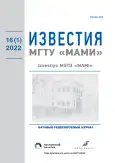Validation of the CAE model set for a passenger car suspension according to loading criteria
- Authors: Kulagin V.A.1
-
Affiliations:
- Central Scientific Research Automobile and Automotive Engines Institute “NAMI”
- Issue: Vol 16, No 1 (2022)
- Pages: 39-50
- Section: Transport and transport-technological facilities
- URL: https://journals.rcsi.science/2074-0530/article/view/100044
- DOI: https://doi.org/10.17816/2074-0530-100044
- ID: 100044
Cite item
Full Text
Abstract
BACKGROUND: Development of numerical methods and technology of computer-aided engineering, used in vehicle design, has reached its high level. Results of virtual experiments cannot be totally relied upon without verifying results obtained with the developed mathematical model. That is why the present paper concentrates on the relevant issue of validation of the CAE models, applicable for vehicle suspension components dynamic load analysis.
AIMS: Goal of the research is adequacy confirmation of developed requirements to preparation of simulation models, applicable for dynamic load and fatigue analysis, by means of numerical simulation with validation analysis.
METHODS: CAE models validation is carried out with a comparative method of results obtained from either laboratory or proving ground testing and simulation of a physical object. Strain gauging results are taken for the comparison. The Models are prepaired with using MBS and FEM technologies.
RESULTS: Validation showed of validation show a good convergence of modelling and experiment results, that confirm adequacy of developed requirements to creation of CAE models, applicable for load and fatigue analysis of vehicle suspension components. The selected convergence evaluation criteria have not been used in similar papers yet and have shown an effective outcome of quantitative and qualitative comparison of loading condition of suspension parts in a variety of boundary conditions of mechanical system simulation.
CONCLUSIONS: Validated CAE models of a passenger car suspension, developed accelerated loading cycle, the model design and dynamic loading simulation approach can be used for chassis parts load analysis and fatigue prediction during early stages of development and as support of testing.
Full Text
##article.viewOnOriginalSite##About the authors
Victor A. Kulagin
Central Scientific Research Automobile and Automotive Engines Institute “NAMI”
Author for correspondence.
Email: viktor.kulagin@nami.ru
ORCID iD: 0000-0003-0158-1727
SPIN-code: 2488-6808
First Grade Design Engineer The MBS Division of the «Numerical Analysis and Virtual Validation» Center
Russian Federation, 2, Avtomotornaya street, Moscow, 125438References
- GOST R 57700.23-2020. Computer models and simulation. Validation. General position. Available from: https://docs.cntd.ru/document/573114589 Accessed: Jun 13, 2022. (In Russ).
- Kulagin VA. Razrabotka kompleksa matematicheskikh modelei podveski legkovogo avtomobilya dlya analiza ustalostnoi dolgovechnosti. Izvestiya MGTU «MAMI». 2021;(4):33–42. (In Russ).
- Hairer E. Numerical Methods for the Solution of ODE and DAE // Hairer E, Nørsett SP, Wanner G. Springer Series in Computational Mathematics. Berlin: Springer; 1993.
- Mostovaya skhema tenzorezistora TML [Internet]. Available from: https://www.tmljp.ru/upload/iblock/191/Мостовая%20схема%20тензорезистора.pdf Accessed: Jun 11, 2022. (In Russ).
- HBM [Internet]. The Wheatstone Bridge Circuit. Available from: https://www.hbm.com/en/7163/wheatstone-bridge-circuit Accessed: Jun 11, 2022.
- Johannesson P. Guide to Load Analysis for Durability in Vehicle Engineering. Johannesson P, Speckert M, editors. Chichester: Wiley; 2014.
- Kornev AE, Bukanov AM, Sheverdyaev ON. Tekhnologiya elastomernykh materialov: uchebnik dlya vuzov. Moscow: MGOU; 2001. (In Russ).
Supplementary files












